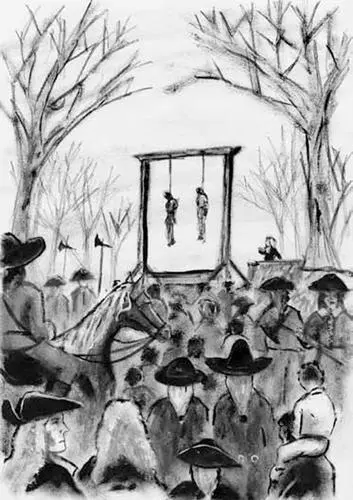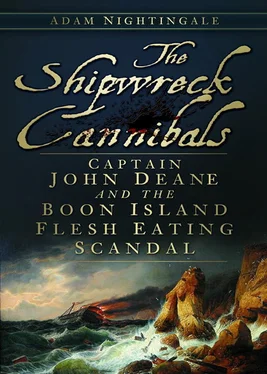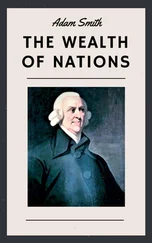In November 1745 Charles Stuart felt empowered and emboldened enough to march on London. He led 5,000 men across the Scottish border and into England. The soldiers making their way north and their enemies marching south seemed to miss one another. The Jacobites marched through Carlisle and Manchester on their way to take London and oust George II from the throne of England. By December, Charles Stuart and his Highland army had arrived at Derby, less than fifteen miles from Nottingham.
Nottingham feared that it would be plundered. A wealthy couple buried their valuables in an oat sack in their yard. Many in Nottingham were angry that the local government had previously dismantled its old siege defences.
Charles Stuart had hoped to ignite English Jacobite fervour as he led his army towards the capital. He had hoped to arrive in London with a great and well-armed host. But English Jacobites stayed indoors, or else simply did not exist in numbers vast enough to risk raising their heads above the parapet. Charles Stuart and his Highlanders occupied Derby for two days before retreating from the Midlands and marching back to Scotland.
On 17 April 1746 the two armies met at the field of Culloden. By this stage in the conflict, Charles Stuart had withdrawn from his own soldiers. He let them fight without him. What happened over the course of the day simultaneously confirmed and negated the two schools of thought regarding the Jacobite threat. On the one hand the old Hanoverian nightmare had come true. The Jacobites were on sovereign British soil with an army. On the other hand, the reality of the Jacobite threat proved to be tragically overinflated. The Jacobites were undisciplined, poorly equipped and divided among themselves. It took the British Army one hour to slaughter their opponents, killing and wounding between 1,500 and 2,000 Jacobites, while losing only 50 men. When the soldiers that John Deane had helped pay for returned to Nottingham, they were lauded as heroes. A kettle drum, a flag and a flagstaff would be placed opposite the entrance to the council chambers to commemorate Nottingham’s part in the victory. Over 100 years later, in one of the Victorian chronicles of the history of Nottingham, two butchers’ apprentices were praised for having killed ‘fourteen of the enemy with their own swords’ at Culloden. The reality was far more squalid. Kingston’s Light Horse were held in reserve for a portion of the battle. When the clan McDonald broke and ran, Kingston’s Light Horse were sent in pursuit. They encountered a group of Irish mercenaries who held their ground, kept their discipline and engaged the Light Horse. In electing to fight back, the Irish proved too fierce for Kingston’s mounted soldiers. Kingston’s men left the Irish alone and ran down and killed escaping Highlanders. Families of the Jacobite combatants were watching the battle. Kingston’s mounted soldiers turned on them and killed women and children. They rode into Inverness and killed Jacobites there. Kingston’s Light Horse carried on their murderous pilgrimage the length and breadth of the road to Inverness.
Whether John Deane knew what his money had actually paid for, or whether he embraced the official version of events is not known. His thoughts on Culloden are not recorded. But had he been fully aware of the atrocities he had funded, how would he have reacted? John Deane believed in honour in warfare. When Deane had fought in the Great Northern War he had held his ally, the Count de Buss, and the Italian mercenaries he had commanded in utter contempt for burning five timber boats and killing the crew. One can only speculate as to whether John Deane would have been able to arrest his deep-rooted hatred of the Jacobites enough to extend to their civilian dead the same military objectivity.
T here was one more moment of drama left for John Deane to endure. It was brief and created a final headline for the veteran of Boon Island. In 1748 John Deane was attacked and robbed on his own estate. The attack took place in daylight. The thief took everything of monetary value on Deane’s person. Deane’s coat sported some fancy sleeve buttons, which the thief cut off. The thief’s Christian name was not recorded. His surname was Miller. He was arrested soon after the theft. He was tried, found guilty and sentenced to hang. Nottingham’s executions invariably took place on a permanent scaffold just outside the town atop a ridge known as Gallows Hill. Miller was hanged publicly alongside a highway robber. Prior to death, it was customary to parade the condemned through the street in chains, either on foot or on the back of a cart. Hanging was a crude science in the 1700s. In Nottingham it meant being thrown off a cart with a short rope tied around the neck. Death would occur after approximately fifteen minutes of strangulation. A large crowd would always attend a public hanging. It is not known whether John Deane watched Mr Miller’s execution.

A Mr Miller was hanged alongside a highway robber for a violent assault perpetrated on John Deane. Illustration by Stephen Dennis
24
Last Will and Testament
A lthough Deane appeared to have written very little during this last period of his existence, there was one official document that cast small spots of light on his private life during his final years. In 1755 John Deane drafted his will.
There was a disjointed and fractious family to provide for. John Deane made provision for his sister Martha and her daughter Mary in the event that Martha died, the implication being that Martha was a widow as her husband was not mentioned at all. John and Sarah Deane had no children of their own. Deane made provision for his heir. Mary, John Deane’s niece, the only surviving child of his brother Jasper, stood to inherit her uncle’s estate when Sarah died. In the meantime, on John Deane’s death, a yearly sum was to be paid to Mary from the interest on £100 from his estate. Deane seemed to regard Mary as profligate as the sum came with a warning to spend the money responsibly and not to ‘waste it’. The conditions attached to Mary’s children receiving money were strict. Mary’s husband Edward, his children, and possibly Mary, clearly did not get on with Sarah Deane. There appeared to have been a serious dispute in the past. Consequently, once John Deane was dead, if Mary and Edward wanted their annuity, they needed to keep their distance from Sarah. A legal cordon was placed around Sarah to protect her. Edward and Mary were forbidden from venturing within 40 miles of John Deane’s wife or they would not receive their money. Deane made arrangements to have the news of his death delivered to Mary and Edward, and the conditions of his will physically taken to them, a measure employed to prevent his relatives coming to Wilford and harassing Sarah Deane. Any money afforded to Mary and Edward’s children was at Sarah Deane’s discretion until the children reached their twenty-first birthdays.
John Deane made generous provision for Sarah. He referred to her in the document as, ‘my beloved wife’, and, ‘my said loving wife’. Sarah was to receive ‘all and singular my personal estate’, and after tax, ‘the rents of profits of all my said lands and tenements’, so long as she remained a widow. But Sarah’s remarriage or death would result in John Deane’s trustees taking over the estate in the event that it had not been administered.
Deane set aside £5 to be distributed in the first month of every year among the poor of Wilford for as long as his wife was alive. Deane made it a condition of his will that whoever might buy his estate would ‘stand up for the general interests of’ the population of Wilford and ‘not seek to oppress’ them. His namesake and nephew John Deane Broughton, the son of his sister Martha, was to receive £20 to be paid within a year of John Deane’s death.
Читать дальше













